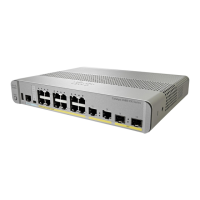48-13
Catalyst 3750-X and 3560-X Switch Software Configuration Guide
OL-21521-01
Chapter 48 Configuring IP Multicast Routing
Configuring IP Multicast Routing
In populating the multicast routing table, dense-mode interfaces are always added to the table.
Sparse-mode interfaces are added to the table only when periodic join messages are received from
downstream devices or when there is a directly connected member on the interface. When forwarding
from a LAN, sparse-mode operation occurs if there is an RP known for the group. If so, the packets are
encapsulated and sent toward the RP. When no RP is known, the packet is flooded in a dense-mode
fashion. If the multicast traffic from a specific source is sufficient, the receiver’s first-hop router might
send join messages toward the source to build a source-based distribution tree.
By default, multicast routing is disabled, and there is no
default mode setting. This procedure is required.
Beginning in privileged EXEC mode, follow these steps to
enable IP multicasting, to configure a PIM
version, and to configure a PIM mode. This procedure is required.
Command Purpose
Step 1
configure terminal Enter global configuration mode.
Step 2
ip multicast-routing distributed Enable IP multicast distributed switching.
Step 3
interface interface-id Specify the Layer 3 interface on which you want to enable multicast
routing, and enter interface configuration mode.
The specified interface must be one of the following:
• A routed port: a physical port that has been configured as a Layer 3
port by entering the no switchport interface configuration
command.
• An SVI: a VLAN interface created by using the interface vlan
vlan-id global configuration command.
These interfaces must have IP addresse
s assigned to them. For more
information, see the “Configuring Layer 3 Interfaces” section on
page 13-37.
Step 4
ip pim version [1 | 2] Configure the PIM version on the interface.
By default, Version 2 is enabled and is the recommended setting.
An interface in PIMv2 mode automatically do
wngrades to PIMv1 mode
if that interface has a PIMv1 neighbor. The interface returns to Version 2
mode after all Version 1 neighbors are shut down or upgraded.
For more information, see the “PIMv1
and PIMv2 Interoperability”
section on page 48-11.
Step 5
ip pim {dense-mode | sparse-mode |
sparse-dense-mode}
Enable a PIM mode on the interface.
By default, no mode is configured.
The keywords have these meanings:
• dense-mode—Enables dense mode of operation.
• sparse-mode—Enables sparse mode of operation. If you configure
sparse mode, you must also configure an RP. For more information,
see the “Configuring a Rendezvous Point” section on page 48-24.
• sparse-dense-mode—Causes the interface to be treated in the mode
in which the group belongs. Sparse-dense mode is the recommended
setting.
Step 6
end Return to privileged EXEC mode.

